Naturally, it’s difficult to assess any athlete’s body of work when he/she has not yet finished playing. With this being said, Tom Brady, at age 36, and Peyton Manning, at age 37, are in their last acts as quarterbacks in the National Football League. That’s not to say that this last act for each of these quarterbacks won’t be amazing. Plenty of quarterbacks have led their respective teams to the playoffs and even to Super Bowls past the age of 35. Take a look below at the decorated list of QB’s past age 35 who have led their teams to playoff berths and for some, Super Bowls:
- John Elway – captured the Super Bowl during his age 37 & 38 seasons (’97 & ’98)
- Kurt Warner – led the Arizona Cardinals to the ’08 Super Bowl during his age 37 season. Warner would follow this Super Bowl run up the following year (his age 38 year) with a playoff win in the wild card round and hard-fought loss in the divisional round against the talented Green Bay Packers, who were led by precocious QB Aaron Rodgers.
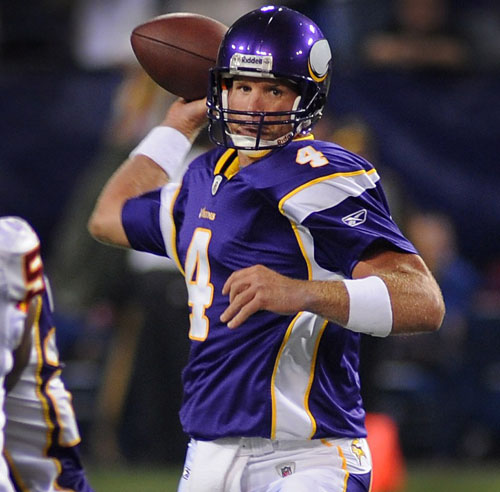
Image courtesy of: www.vikingsmania.com
- Warren Moon – set a completions record (404) at age 35 during the ’91 campaign and during his age 38/39 season threw for 4,228 yards and 33 touchdowns (incredible). Though the Vikings did not make the playoffs that year, Moon did lead them to the playoffs the year prior during his age 37/38 season.
- Brett Favre – During his age 39/40 season (’09 campaign), which was his first year with the Minnesota Vikings, Favre played all 16 games and threw for 4,202 yards and a whopping 33 touchdowns (while in the process making Sidney Rice a fantasy stud). That year, he led the Vikings to a last second loss in the NFC championship game against the Saints, where Favre’s interception in the waning moments led to a Saints field goal that ended the Vikings season. To put Favre’s season in context, he hadn’t eclipsed 4,200 yards in a season since the ’98 campaign, which was only his 7th season as a starting quarterback. Favre’s yards per attempt in ‘09 were 7.91, the highest yards per attempt in his career by a long shot. His 33 touchdowns were also his highest total since the ’97 campaign, when he was only 28 years old. Favre was otherworldly that season and had the best season of a 40 or older QB in the history of NFL…hands down.
This brings me to Brady and Manning. If anyone were to put together a more prolific age 40 season than Favre, I would bet money on one of these two guys to accomplish this. Although Favre’s vintage season will be hard to top.
In the ensuing argument that pits Manning against Brady, I am going to examine a variety of factors including supporting cast, statistics, playoff statistics, playoff win/loss record (including Super Bowl) and head-to-head performance.
With no further ado, I’ll delve into one of the most hotly contested topics of this millennium: who’s had the better career, Tom Brady or Peyton Manning?
Regular Season Statistics
It’s tough to compare Brady to Manning in an apples-to-apples argument, since Manning has essentially played three more seasons that Brady to this point (14 seasons for Manning to Brady’s 11 seasons). Brady played only 1 game his rookie year and missed all but one quarter in the 2008 season, so I’m not counting those seasons. Manning has been in the league for 15 seasons, but missed the 2011 campaign due to his recovery from three neck procedures that summer…hence the 14 seasons played to date.
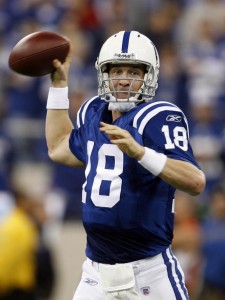
Image courtesy of: www.celebritynetworth.com
With that being said, I’m taking Brady’s last three healthy years (’10, ’11 & ’12) and extrapolating those out to account for him having played three less seasons than Manning. What you will find is that Manning’s regular season statistics still edge Brady’s, when you compare Manning’s 14 seasons to Brady’s 14 seasons (11 real seasons + 3 projected seasons).
Here’s a look at their splits through 3 games in the 2013 season. I haven’t messed with Brady’s numbers here, so this isn’t an apples-to-apples comparison (since Manning has played 3 more seasons than Brady):
Manning: 227 games played, 5,171 completions, 65.3 completion %, 60,630 yards, 7.66 avg. yards/completion, 448 TD’s, 209 interceptions & a career QB rating of 96.3
Brady: 180 games played, 3,871 completions, 63.6 completion %, 45,504 yards, 7.48 avg. yards/completion, 339 TD’s, 125 interceptions & a career QB rating of 96.3
That last number, the 96.3 QB rating is insane…how do both Brady and Manning have the identical career QB rating? I mean what are the odds of that??
Now let’s tack on three more seasons to Brady’s numbers (assuming he’s healthy for all 16 games in each of these seasons), using ’10, ’11 and ’12 as proxies to determine these three seasons. This isn’t too much of a stretch since Brady has played all 16 games in 10 of his 12 seasons in the NFL (this excludes his rookie year when he appeared in only 1 game).
Brady: 228 games played, 4,997 completions, 63.9 completion %, 59,466 yards, 7.48 avg. yards/completion (kept this the same), 448 TD’s, 123 interceptions and the QB rating remained the same, at 96.3. Here are Manning’s numbers again:
Manning: 227 games played, 5,171 completions, 65.3 completion %, 60,630 yards, 7.66 avg. yards/completion, 448 TD’s, 209 interceptions & a career QB rating of 96.3
This gets a lot closer when you even up their seasons played, using Brady’s last three seasons as proxies for his next three seasons. Manning beats Brady by 3.5% in completions, by 2.2% in completion %, by 1.9% in total yards and by 2.4% in avg. yards/completion, while TD’s are tied exactly, at 448 (eerie). Brady also has an unsightly 58 career fumbles, which is 18 more than Manning has committed in his career.
The only metric Brady beats Manning in is in interceptions, where he is projected to have 86 less interceptions than Manning.
Based on pure regular season performance, Manning gets the nod here. He’s one of the top 5 best QB’s to ever play this game (Brady is as well), and is known for being the most prolific passer of his generation and more than likely, of all-time, when his career is all said and done in a few years.
Winner: Manning
Offensive Supporting Cast
Before researching this section, I spoke to my roommate about this and my gut reaction was that Peyton Manning has had more weapons at his disposal throughout the majority of his career than Tom Brady has had.
Let’s examine Tom Brady’s offensive weaponry first. When I think of Brady, I think of his early years with the Pats (’01 – ’06) and look at his supporting cast on offense as being generally underwhelming. He was throwing predominantly to the likes of David Givens, Deion Branch, Troy Brown, David Patten and Kevin Faulk for this six-year stretch. Guess how many 1,000 yard receiving seasons these five receivers combined to generate for Brady (Faulk was a RB, but that’s not the point here)….1 season. 1 friggin season!! Are you kidding me? This lone 1,000 yard season belonged to Troy Brown, who registered 1,199 yards during the 2001 campaign.
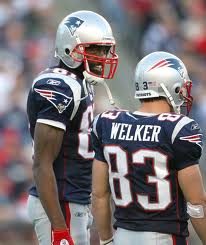
Image courtesy of: www.zimbio.com
Not until Brady’s age 30 season (in ’07) did the Patriots finally invest in quality receivers that likely will be Hall-of-Famers when it’s all said and done. Randy Moss arrived during his age 30 season as well, while Wes Welker was acquired by the Patriots that summer, entering his age 26 season. The rest is history. In Welker’s six-year stint with New England, he registered five 1,000 yard seasons, exceeding 1,300 yards in three of these campaigns. Moss only stuck for 3 years before being traded four games into the 2010 campaign (the beginning of his 4th season with the team). Nevertheless, he transformed that offense instantly, rolling up 1,493 yards and 23 touchdowns in the 2007 season (breaking the most TD’s in a season by a wide receiver in NFL history, which Jerry Rice held for 20 years, with 22 TD’s in ‘87).
Since 2010, the Patriots have employed many double-tight end formations, with Rob Gronkowski and Aaron Hernandez forming the most potent 1-2 Tight End punch in the league. That is until the summer of 2013, when Hernandez was indicted on charges of murdering his friend, which promptly ended his NFL career.
The final piece of Brady’s puzzle is the running backs that have lined up behind him. The list certainly isn’t too decorated. The only ‘back that was a stud was Corey Dillon who gave the Pats 1 transcendent year (1,635 yards rushing & 12 TD’s in ‘04) and two good years (12 & 13 TD’s, respectively during his next two seasons). The fact remains that Tom Brady has spent the majority of his career playing with washed up ‘backs, busts and limited running backs. These included the likes of Laurence Maroney (4 seasons of service – biggest Patriots bust of the last decade), Sammy Morris (4 seasons of service – good tough runner & run blocker, but not an every down back), Fred Taylor’s corpse (2 injury plagued seasons at the tail-end of his career), Kevin Faulk (played 13 seasons & served as the Patriots’ swiss army knife out of the back-field) and more recently, Stevan Ridley (starting his 3rd season with the Patriots, after a 1,263 yard & 12 TD campaign in ’12).
Brady is behind the 8-ball. Outside of one transcendent year of Corey Dillon and a great year from Ridley in 2012, his running backs have been at best mediocre and at worst, awful (re: Maroney, Laurence). Brady’s tight ends in recent years have been best in class, while for the majority of Brady’s career, his receivers have been sub-par. Welker and Moss’ 3-year run together with the Patriots represented the apex of the Patriots receivers in the Tom Brady era.
Now on to Manning, who has enjoyed some of the best receivers a quarterback could ask for:
Reggie Wayne – 8 seasons of 1,000 yards, 13.5 yards/catch, 79 career TD’s (age 34)
Marvin Harrison – 8 seasons of 1,000 yards, 13.2 yards/catch, 128 career TD’s (retired after ’08 season)
Brandon Stokley – 1 season of 1,000 yards, 13.5 yards/catch, 39 career TD’s (age 37)
Eric Decker – 1 season of 1,000 yards, 13.2 yards/catch, 23 career TD’s (age 26)
Demaryius Thomas – 1 season of 1,000 yards, 15.3 yards/catch, 18 career TD’s (age 25)
Wes Welker – 5 seasons of 1,000 yards, 11.1 yards/catch, 42 career TD’s (age 32)
That’s an embarrassment of riches at the wide receiver position. I’m not even bringing up Jerome Pathon, Austin Collie and Pierre Garcon, who were all quality receivers for Manning for several years at different points in his career. And you have to figure that Manning plays at least another 2-3 seasons with those last three guys (Decker, Thomas & Welker). Meanwhile, Brady’s throwing to a rag-tag crew of rookies and marginal veterans in 2013, which include Aaron Dobson, Kenbrell Thompkins and Julian Edelman. As is evidenced by Brady’s on-field comportment this year, he’s clearly stewing about his wide receiver situation.
On to running backs for Peyton now…
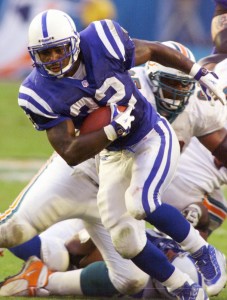
Image courtesy of: www.marconews.com
Regardless of what happens in Denver during the next several seasons, the running back conversation starts and ends with Edgerrin James, who was one of the best backs of the 2000’s. James entered the league a year after Manning (in ’99), and enjoyed 5 seasons of 1,000 yards rushing, while eclipsing 1,500 yards in four of those seasons. James then was allowed to walk to the Cardinals, where he enjoyed a pair of 1,150+ yard seasons. In total, James accounted for 7 seasons of 1,000 yards, while rushing for 4.0 yards/carry (solid) and accounting for 91 total touchdowns (80 rushing & 11 receiving). Once Edge left in the summer of ’06, Joseph Addai came in and filled in capably as the lead back, rushing for more than 1,000 yards in back-to-back seasons. ‘Nuff said, Peyton enjoyed playing with one of the best running backs of his generation (Edge) and three (likely) future Hall of Famers (Wayne, Harrison & Welker).
While Manning didn’t use his tight-ends as much as Brady has in the past several seasons, Manning still enjoyed playing with Dallas Clark for eight seasons (1x Pro Bowler) and Marcus Pollard for seven seasons smack in the middle of Peyton’s prime. During this time, Clark reeled in 44 TD’s, while Pollard pulled in 34 TD’s…not bad for being Manning’s 3rd and 4th options in the offense.
Who did more with less? Tom Brady. While you could argue that Peyton enhanced the abilities of his receivers and made them look better than they really were (true to some extent), Wayne’s post-Manning seasons have been great though, with his 2012 campaign of 1,355 yards and 5 touchdowns, representing one of his best seasons to date. There’s hardly an argument here, Brady wins in a landslide.
Winner (meaning did more with less): Tom Brady
Playoff Performance & Playoff Win/Loss Record
In the NFL, every argument starts and ends with Super Bowls and playoff performances by elite quarterbacks. For NFL fans, Brady and Manning have been making the playoffs regularly for the last decade, but each has stumbled at key moments. Brady’s Patriots fell to the Giants in the ’07 & ’11 Super Bowl in two tightly contested games, while Manning’s Colts (at the time) lost Super Bowl XLIV to the Saints and fell short in overtime of the AFC championship last year against the Baltimore Ravens. Manning last won a Super Bowl in February of ’07, during his age 30 season, while Brady last held the Lombardi Trophy in his age 27 season. Crazy to think it’s been that long since either of these guys has won a Super Bowl.
Let’s dig a bit deeper into their postseason performances and compare their splits:
Manning: 20 games, 481 completions, 63.2 completion %, 5,679 yards, 284 yards/game, 7.46 yards/attempt, 32 TD’s, 21 INT’s, 1.52 TD-to-INT rate, 3 fumbles
Brady: 24 games, 553 completions, 62.3 completion %, 5,949 yards, 248 yards/game, 42 TD’s, 22 INT’s, 1.91 TD-to-INT rate, 8 fumbles
There are a few items that stand out to me when comparing Manning and Brady’s playoff splits:
- Brady’s 8 career playoff fumbles are unsightly and a glaring black mark on his otherwise stellar postseason numbers. This is 2.5x the number of fumbles Manning has committed.
- Manning has always put up better statistical passing numbers than Brady, that’s just a fact. This is borne out in Manning’s regular season stats, as well as supported in his playoff splits. Manning completes more of his passes, throws for 36 yards more per game and commits less fumbles than Brady.
- On the flip side, Brady does have nearly a 26% better TD-to-INT ratio than Manning, 1.91 TD-to-INT ratio to Manning’s 1.52 TD-to-INT ratio. Here’s my take: Brady is a bit more precise and outside of Moss’ three years in New England, the Patriots’ passing attack has always been about precision and short to medium routes, as opposed to a more vertical attack. This stands in stark comparison to Manning’s offense, which has utilized the vertical passing attack (with Thomas & Decker in Denver) and with Marvin Harrison and Reggie Wayne in Indianapolis. As a result, Manning tends to take more chances downfield, which results in a larger share of his balls getting picked off.
- Manning did not play well in his lone Super Bowl year in ’06. He threw for 1,034 yards in the postseason, good for 259 yards/game but his TD-to-INT ratio was downright putrid. He threw 3 TD’s that postseason against a whopping 7 INT’s, which correlates to a .43 TD-to-INT ratio. Yikes! How did the Colts win that year with Manning putting up those numbers? The Colts stomped a toothless Kansas City team in the wild card round, 23-8 and then beat Baltimore in the AFC divisional round, in a game of field goals, 15-6. This was Steve McNair’s last relevant season as a pro. Indy’s only tough match-up that postseason was beating Tom Brady’s Patriots in an all-time classic AFC championship game that came down to a touchdown in the final minute by the Colts, behind the blocking of their superb offensive line. The Colts would go on to win that game, 38-34, when Brady was intercepted in the final 30 seconds. The Colts then played the Chicago Bears, who had one of the best defenses in recent memory but was quarterbacked by Rex Grossman, who would be a back-up within the next 12 months.
- Hard to believe that during Brady’s first championship run in 2001, he threw for only 572 yards that postseason (191 yards/game) and committed more turnovers (2) than he threw touchdowns (1). Since that season, Brady has had only one postseason since the ’01 campaign where he has committed more turnovers than touchdowns (‘09)
At the end of the day, Brady and Manning have played well enough to win a ton of games in the playoffs. Critics will go on and on about both QB’s wasting opportunities but their stats don’t lie. These guys put up numbers in the playoffs that rival anyone’s in the business.
Brady wins this section due to his team success in the postseason. While Manning may throw for more yards, have a better completion percentage and throw for more completions/game, Brady just flat out wins.
Brady has the most postseason wins of any quarterback in the history of the NFL, with 17, surpassing his childhood idol, Joe Montana in last year’s playoffs, who has 16 postseason wins to his name. Brady has only 6 postseason losses, giving him a stellar 73.9% winning percentage in the postseason. Contrast this with Peyton Manning, who has 9 wins against 11 losses in the playoffs, for a 45% winning percentage. Granted Manning is still tied for 9th on the all-time postseason wins list for QB’s. The fact of the matter is the Colts have suffered too many one-and-done’s in the postseason (8x), while Brady has failed to win a postseason game only two times.
Winner: Brady
Head to Head Matchups
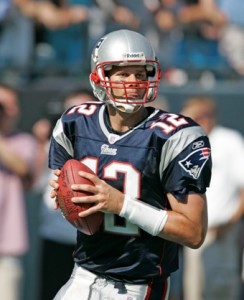
Image courtesy of: Boston.com
Tom Brady leads the head-to-head against Manning, with the Pats going 9-4 against Manning’s teams. However, Manning has gone 4-3 against Brady in the last seven games after losing the first six meetings. This includes vanquishing Brady’s Pats in the 2006 (played in Jan ’07) AFC championship game, in Manning’s Super Bowl winning season. In the postseason, Manning and Brady have met three times (twice in the AFC championship game) with the Pats winning two of those three games. But, the quarterbacks have each won one AFC championship game against the other, with Manning winning in ’07 and Brady winning in ’04.
Even with Manning’s recent success against Brady, the scales tip in Brady’s favor, in both the regular season and postseason. Manning still has time to turn this around, but Brady owns the head-to-head matchups for now.
Winner: Brady
While the book on this debate is far from closed, this post at least provides a framework for assessing Manning’s first 14 seasons and Brady’s first 11 seasons side-by-side. I still believe that Brady and Manning have at least another two good seasons in them beyond the 2013 campaign, so there is still much to be written about these two. What if Manning leads the Broncos to back-to-back Super Bowl victories? Then all of a sudden, we’re talking about Manning as the greatest quarterback of all-time, with three rings and all of the individual passing records to his name (most completions, most TD’s, etc).
But to this point, if you were to ask me whose career I would rather have, I would choose Brady. Although Manning is on track to break a ton of passing records (several of which are held by Brett Favre), Brady has three rings in five Super Bowl appearances. He is the most successful postseason quarterback in the history of the NFL, and for good measure, he has a smoking hot model wife. I take Brady’s career over Manning’s at this point in time (September, 2013). But as I said before, I may be re-thinking this in a year or two from now, if Manning were to win another Super Bowl or two.
The beauty of sports is that this argument will be played out on the field, in front of all critics, journalists and pundits. For now we argue for either Brady or Manning tooth-to-nail, but the final assessment won’t occur for another several years. Until then, let’s enjoy these two Hall-of-Famers and hope that they meet at least a couple more times before it’s all said and done.
 Follow
Follow


Jim – a well-researched article, and a good read – thanks for posting this!
About the Brady vs. Manning debate … hard to argue with your conclusions here, and I have to admit to more than a little bias.
Both quarterbacks are having impressive seasons, as of early Oct., and neither appears ready to close out their careers. Brady continues to win games this year, with one of his weakest supporting casts in years, because like all the greats, he motivates and elevates the play of all those around him, as you’ve so eloquently make the case above.
Peyton is on track to break all personal and single-season records offensive records. Year after year, game after game, he continues to get better – and like Brady, he raises the level of success of all his teammates. With Peyton, the Broncos have an offensive coordinator under center. He can read defenses and utterly demoralize an opposing defense – perhaps better than any other quarterback ever. Let’s hope Peyton can translate those numbers into wins in the post-season, and especially in the form of championships.
About my biased perspective – as a long-time Colorado resident and Bronco fan, I’m rooting for Peyton and the Denver Broncos to win it all. And to do it again next year. And maybe another year after that… But despite my loyalty here, I appreciate what Brady has done, and what he’s accomplishing this season, too.
I recently heard it suggested that the greatest weapon in the NFL right now is Peyton’s brain – if you’ve watched him over the last month, it’s hard to argue with that. Brady, Manning, Favre, Elway, Warner, and other ‘old guys’ pulling the trigger demonstrate that with age and experience, quarterbacks develop uncanny skills at reading defenses, adapting to fast-moving conditions during drives, and reacting instantaneously as plays develop. It’s a skill I’ll never experience – but I certainly enjoy watching it!
In the NFL, as in most sports, true excellence and greatness is measured by championships won. Brady clearly has the advantage here. Peyton and his teammates didn’t close out last year against the Ravens – they had the game won and didn’t finish the job. Like Elway in 1996 against Jacksonville, he now has the chance to learn from that and complete this year what was left unfinished last year.
While Peyton and the Broncos are my favorites, I respect and appreciate what both of these greats have done in their long careers. It’s going to be a fun and fascinating season!
Uncle Bob, I couldn’t have put this any better…I completely agree. Thanks for your comment and your support, I really appreciate it!
I’d like to point out a minor flaw in your projections. According to what you put down as Brady’s stats through 180 games, Brady had thrown 125 INTs, yet when you put up your stats including the three projected seasons, Brady ends up with 123 INTs. How exactly does one throw negative 2 INTs in 3 yrs? Doesnt make sense.